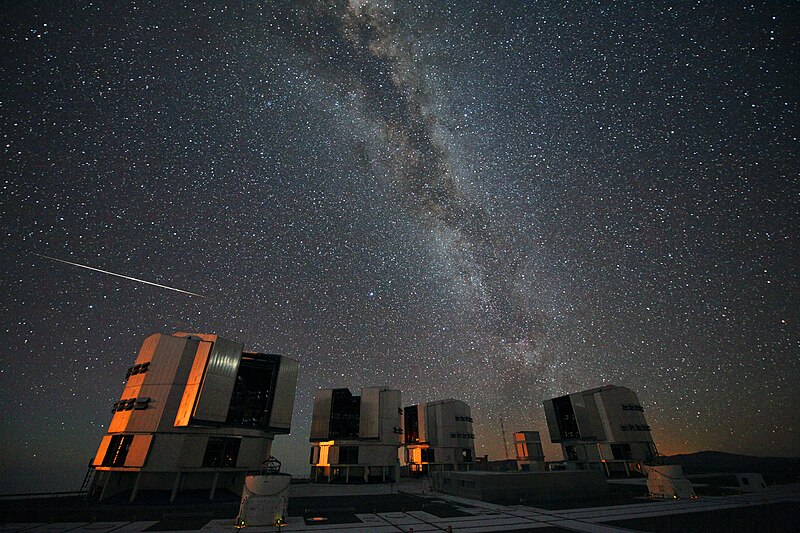Tập tin:The 2010 Perseids over the VLT.jpg

Kích thước hình xem trước: 800×533 điểm ảnh. Độ phân giải khác: 320×213 điểm ảnh | 640×427 điểm ảnh | 1.024×683 điểm ảnh | 1.280×853 điểm ảnh | 2.560×1.707 điểm ảnh | 5.616×3.744 điểm ảnh.
Tập tin gốc (5.616×3.744 điểm ảnh, kích thước tập tin: 5,68 MB, kiểu MIME: image/jpeg)
Lịch sử tập tin
Nhấn vào ngày/giờ để xem nội dung tập tin tại thời điểm đó.
| Ngày/giờ | Hình xem trước | Kích cỡ | Thành viên | Miêu tả | |
|---|---|---|---|---|---|
| hiện tại | 17:32, ngày 19 tháng 2 năm 2024 |  | 5.616×3.744 (5,68 MB) | C messier | full size |
| 09:34, ngày 18 tháng 8 năm 2010 |  | 4.000×2.667 (5,82 MB) | Lars Lindberg Christensen | {{Information |Description={{en|1=Every year in mid-August the Perseid meteor shower has its peak. Meteors, colloquially known as “shooting stars”, are caused by pieces of cosmic debris entering Earth’s atmosphere at high velocity, leaving a trail o |
Trang sử dụng tập tin
Có 2 trang tại Wikipedia tiếng Việt có liên kết đến tập tin (không hiển thị trang ở các dự án khác):
Sử dụng tập tin toàn cục
Những wiki sau đang sử dụng tập tin này:
- Trang sử dụng tại af.wikipedia.org
- Trang sử dụng tại ar.wikipedia.org
- Trang sử dụng tại en.wikipedia.org
- Trang sử dụng tại eo.wikipedia.org
- Trang sử dụng tại es.wikipedia.org
- Trang sử dụng tại fa.wikipedia.org
- Trang sử dụng tại gl.wikipedia.org
- Trang sử dụng tại he.wikipedia.org
- Trang sử dụng tại hr.wikipedia.org
- Trang sử dụng tại hu.wikipedia.org
- Trang sử dụng tại it.wikipedia.org
- Trang sử dụng tại la.wikipedia.org
- Trang sử dụng tại mk.wikipedia.org
- Trang sử dụng tại ml.wikipedia.org
- Trang sử dụng tại ms.wikipedia.org
- Trang sử dụng tại my.wikipedia.org
- Trang sử dụng tại nn.wikipedia.org
- Trang sử dụng tại pl.wikipedia.org
- Perseidy
- Portal:Astronomia/Artykuł miesiąca 08 2012
- Portal:Astronomia/Artykuł miesiąca 08 2013
- Portal:Astronomia/Artykuł miesiąca 08 2014
- Portal:Astronomia/Artykuł miesiąca 08 2015
- Portal:Astronomia/Artykuł miesiąca 08 2016
- Portal:Astronomia/Artykuł miesiąca 08 2017
- Portal:Astronomia/Artykuł miesiąca 08 2018
- Portal:Astronomia/Artykuł miesiąca 08 2019
- Portal:Astronomia/Artykuł miesiąca 08 2020
- Portal:Astronomia/Artykuł miesiąca 08 2021
- Portal:Astronomia/Artykuł miesiąca 08 2022
- Trang sử dụng tại ro.wikipedia.org
- Trang sử dụng tại sh.wikipedia.org
- Trang sử dụng tại sk.wikipedia.org
- Trang sử dụng tại sl.wikipedia.org
- Trang sử dụng tại sv.wikipedia.org
- Trang sử dụng tại tr.wikipedia.org
- Trang sử dụng tại www.wikidata.org
- Trang sử dụng tại zh.wikipedia.org
